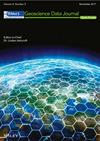Early meteorological records from Corrientes and Bahía Blanca, Argentina: Initial ACRE‐Argentina data rescue and related activities
IF 3.3
3区 地球科学
Q2 GEOSCIENCES, MULTIDISCIPLINARY
引用次数: 1
Abstract
The international Atmospheric Circulation Reconstructions over the Earth (ACRE) initiative works to recover global climate history and build an accessible databank, with data from the past 250 years of terrestrial and marine surface. Argentina is part of that effort with ACRE Argentina recovering data from various sources that have been recorded throughout the country since the 19th century. In this paper, weather observations transcribed from the original records into digital form and taken every day during the years 1860–1879 at Bahía Blanca and from 1873–1886 at Corrientes are presented. The digitization was carried out through the project Meteorologum ad Extremum Terrae (MET) launched in the Zooniverse interface, which is currently working with near 900 citizen scientist volunteers per day. The present analysis corresponds to data retrieved from the collection ‘Anales de la Oficina Meteorológica Argentina’ and contains information on atmospheric pressure, air temperature, relative humidity, cloud cover, cloud types, wind direction, wind speed, rainfall and weather remarks. For the present analysis, only temperature and pressure values, measured in °C and mm of Hg, respectively, were considered, after a quality control of the digitization process was applied. Data values were tested and used to rebuild the time series of both places and correlation with SOI index and monthly pressure values for both places was tested using Spearman correlation. Results show that the influence of El Niño episode during 1877–1878 can be found in the pressure values at Corrientes.

来自阿根廷Corrientes和Bahía Blanca的早期气象记录:最初的ACRE - Argentina数据救援和相关活动
国际地球大气环流重建计划(ACRE)致力于恢复全球气候历史,并建立一个可访问的数据库,其中包括过去250年陆地和海洋表面的数据。阿根廷是这项工作的一部分,ACRE阿根廷从19世纪以来全国各地记录的各种来源恢复数据。本文介绍了1860-1879年期间在Bahía Blanca和1873-1886年期间在Corrientes每天从原始记录转录成数字形式的天气观测。数字化是通过Zooniverse界面启动的气象与极端地球(MET)项目进行的,该项目目前每天与近900名公民科学家志愿者合作。本分析对应于从“阿根廷官方网站Meteorológica”收集的数据,并包含有关大气压、气温、相对湿度、云量、云类型、风向、风速、降雨量和天气备注的信息。在本分析中,在应用数字化过程的质量控制后,仅考虑温度和压力值,分别以°C和毫米汞柱测量。对数据值进行测试并用于重建两地的时间序列,并使用Spearman相关对两地的SOI指数和月压力值进行相关性测试。结果表明,1877-1878年El Niño事件对Corrientes的压力值有影响。
本文章由计算机程序翻译,如有差异,请以英文原文为准。
求助全文
约1分钟内获得全文
求助全文
来源期刊

Geoscience Data Journal
GEOSCIENCES, MULTIDISCIPLINARYMETEOROLOGY-METEOROLOGY & ATMOSPHERIC SCIENCES
CiteScore
5.90
自引率
9.40%
发文量
35
审稿时长
4 weeks
期刊介绍:
Geoscience Data Journal provides an Open Access platform where scientific data can be formally published, in a way that includes scientific peer-review. Thus the dataset creator attains full credit for their efforts, while also improving the scientific record, providing version control for the community and allowing major datasets to be fully described, cited and discovered.
An online-only journal, GDJ publishes short data papers cross-linked to – and citing – datasets that have been deposited in approved data centres and awarded DOIs. The journal will also accept articles on data services, and articles which support and inform data publishing best practices.
Data is at the heart of science and scientific endeavour. The curation of data and the science associated with it is as important as ever in our understanding of the changing earth system and thereby enabling us to make future predictions. Geoscience Data Journal is working with recognised Data Centres across the globe to develop the future strategy for data publication, the recognition of the value of data and the communication and exploitation of data to the wider science and stakeholder communities.
 求助内容:
求助内容: 应助结果提醒方式:
应助结果提醒方式:


